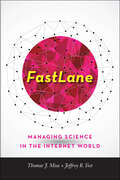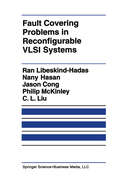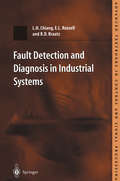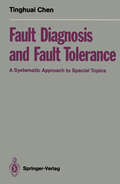- Table View
- List View
Fast Software Encryption: 23rd International Conference, FSE 2016, Bochum, Germany, March 20-23, 2016, Revised Selected Papers (Lecture Notes in Computer Science #9783)
by Thomas PeyrinThis book constitutes the thoroughly refereed post-conference proceedings of the 23rd International Conference on Fast Software Encryption, held in Bochum, Germany, in March 2016. The 29 revised full papers presented were carefully reviewed and selected from 86 initial submissions. The papers are organized in topical sections on operating modes; stream-cipher cryptanalysis; components; side-channels and implementations; automated tools for cryptanalysis; designs; block-cipher cryptanalysis; foundations and theory; and authenticated-encryption and hash function cryptanalysis.
Fast Software Encryption: 13th International Workshop, FSE 2006, Graz, Austria, March 15-17, 2006, Revised Selected Papers (Lecture Notes in Computer Science #4047)
by Matt RobshawThis book constitutes the thoroughly refereed post-proceedings of the 13th International Workshop on Fast Software Encryption, FSE 2006, held in Graz, Austria in March 2006. Presents 27 revised full papers addressing all current aspects of fast and secure primitives for symmetric cryptology, and organized in topical sections on stream ciphers, block ciphers, hash functions, analysis, proposals, modes and models, as well as implementation and bounds.
Fast Software Encryption: 11th International Workshop, FSE 2004, Delhi, India, February 5-7, 2004, Revised Papers (Lecture Notes in Computer Science #3017)
by Bimal Kumar Roy Willi MeierFast Software Encryption: 7th International Workshop, FSE 2000, New York, NY, USA, April 10-12, 2000. Proceedings (Lecture Notes in Computer Science #1978)
by Bruce SchneierSince 1993, cryptographic algorithm research has centered around the Fast So- ware Encryption (FSE) workshop. First held at Cambridge University with 30 attendees, it has grown over the years and has achieved worldwide recognition as a premiere conference. It has been held in Belgium, Israel, France, Italy, and, most recently, New York. FSE 2000 was the 7th international workshop, held in the United States for the rst time. Two hundred attendees gathered at the Hilton New York on Sixth Avenue, to hear 21 papers presented over the course of three days: 10{12 April 2000. These proceedings constitute a collection of the papers presented during those days. FSE concerns itself with research on classical encryption algorithms and - lated primitives, such as hash functions. This branch of cryptography has never been more in the public eye. Since 1997, NIST has been shepherding the Adv- ced Encryption Standard (AES) process, trying to select a replacement algorithm for DES. The rst AES conference, held in California the week before Crypto 98, had over 250 attendees. The second conference, held in Rome two days before FSE 99, had just under 200 attendees. The third AES conference was held in conjunction with FSE 2000, during the two days following it, at the same hotel.
Fast Software Encryption: 5th International Workshop, FSE ’98, Paris, France, March 23–25, 1998, Proceedings (Lecture Notes in Computer Science #1372)
by Serge VaudenayThe Fast Solution of Boundary Integral Equations (Mathematical and Analytical Techniques with Applications to Engineering)
by Sergej Rjasanow Olaf SteinbachThis book provides a detailed description of fast boundary element methods, all based on rigorous mathematical analysis. In particular, the authors use a symmetric formulation of boundary integral equations as well as discussing Galerkin discretisation. All the necessary related stability and error estimates are derived. The authors therefore describe the Adaptive Cross Approximation Algorithm, starting from the basic ideas and proceeding to their practical realization. Numerous examples representing standard problems are given.
The Fast-Track Guide to VXLAN BGP EVPN Fabrics: Implement Today’s Multi-Tenant Software-Defined Networks
by Rene CardonaMaster the day-to-day administration and maintenance procedures for existing VXLAN fabrics. In this book you’ll discuss common issues and troubleshooting steps to help you keep your environment in stable operation. The Fast-Track Guide to VXLAN BGP EVPN Fabrics is a guide for network engineers and architects who can’t spend too much time learning everything about VXLAN. It has been created with the end goal of providing you with a straightforward approach to understand, implement, administer, and maintain VXLAN BGP EVPN-based data center networks. Using this book, you will understand Virtual Extensible LAN (VXLAN) as a technology that combines network virtualization and service provider class network attributes to solve the performance and scalability limitations in a three-tier design. You will learn to combine multiple links and provide equal-cost multipathing to effortlessly scale speed requirements without being worried about potential loops. You will learn VXLAN BGP EVPN configuration procedures with graphical step-by-step examples. You will be introduced to foundational concepts in VXLAN without the need to go over hundreds of documentation pages. This book is a clear and precise guide to implementing a spine and leaf architecture running with VXLAN. It explains how to perform day-to-day maintenance and administration tasks after implementing your first VXLAN fabric. It also explains how to integrate external devices such as firewalls, routers, and load balancers to VXLAN; how to leverage your VXLAN fabric; and how to create multiple tenant networks to secure your critical infrastructure. What You Will Learn Discover the advantages of a VXLAN spine and leaf fabric over a traditional three-tier network designWork with the BGP L2VPN EVPN control plane VXLANExamine the purpose of underlay and overlay in VXLANUse multitenancy and tenant anycast gatewaysConnect your VXLAN fabric to external networks Who This Book Is For Senior network engineers, solutions architects, and data center engineers.
Fast Track to MDX
by Mark Whitehorn Robert Zare Mosha PasumanskyShows users and developers how to use MDX to effectively to provide relevant business information.
Fast Track UML 2.0
by Kendall Scott* Examples are easy to understand; diagrams aren’t overly busy. * Written in user-friendly style author is known for. * Condensed, distilled presentation of the UML Superstructure document will get you up to speed with UML 2.0.
FastAPI Cookbook: Develop high-performance APIs and web applications with Python
by Giunio De LucaEnhance your web development skills, from setting up your environment and advanced integrations to building robust, high-traffic web applications with practical, scalable solutionsKey FeaturesExplore FastAPI in depth, from basic setup to advanced features such as custom middleware and WebSocketsDiscover practical strategies to optimize app performance and handle high trafficImplement SQL and NoSQL integration techniques for versatile data management in FastAPI applicationsPurchase of the print or Kindle book includes a free PDF eBookBook DescriptionFastAPI is a cutting-edge Python framework that is revolutionizing the way web apps and APIs are built. Known for its speed, simplicity, and scalability, FastAPI empowers developers to create high-performing applications with ease. This book will help you leverage FastAPI’s immense potential to handle high-traffic scenarios and integrate seamlessly with modern Python tools. The book begins by familiarizing you with the basics of setting up and configuring your FastAPI environment before moving to the intricacies of building RESTful APIs, managing data with SQL and NoSQL databases, and handling authentication and authorization. Next, you'll focus on advanced topics such as custom middleware, WebSocket communication, and integration with various Python libraries. Each chapter is meticulously crafted with practical recipes, progressing from foundational concepts to advanced features and best practices. The concluding chapters show you how to optimize performance, implement rate limiting, and execute background tasks, empowering you to become a proficient FastAPI developer. By the end of this book, you'll have gained the skills you need to migrate existing apps to FastAPI, and be equipped to tackle any challenge in the modern web development landscape, ensuring your apps are not only functional, but also efficient, secure, and scalable.What you will learnExplore advanced FastAPI functionalities such as dependency injection, custom middleware, and WebSocketsDiscover various types of data storage for powerful app functionality with SQL and NoSQLImplement testing and debugging practices for clean, robust codeIntegrate authentication and authorization mechanisms to secure web appsAcquire skills to seamlessly migrate existing applications to FastAPIWrite unit and integration tests, ensuring reliability and security for your appsDeploy your FastAPI apps to production environments for real-world useWho this book is forThis book is for Python developers looking to enhance their skills to build scalable, high-performance web apps using FastAPI. Professionals seeking practical guidance to create APIs and web apps that can handle significant traffic and scale as needed will also find this book helpful by learning from both foundational insights and advanced techniques. The book is also designed for anyone familiar with RESTful APIs, HTTP protocols, and database systems, as well as developers looking to migrate existing applications to FastAPI or explore its advanced features.
FastLane: Managing Science in the Internet World (Johns Hopkins Studies in the History of Technology)
by Thomas J. Misa Jeffrey R. YostSince 2000, the National Science Foundation has depended upon its pioneering FastLane e-government system to manage grant applications, peer reviews, and reporting. In this behind-the-scenes account Thomas J. Misa and Jeffrey R. Yost examine how powerful forces of science and computing came together to create this influential grant-management system, assessing its impact on cutting-edge scientific research.Why did the NSF create FastLane, and how did it anticipate the development of web-based e-commerce? What technical challenges did the glitch-prone early system present? Did the switch to electronic grant proposals disadvantage universities with fewer resources? And how did the scientific community help shape FastLane? Foregrounding the experience of computer users, the book draws on hundreds of interviews with scientific researchers, sponsored project administrators, NSF staff, and software designers, developers, and managers.
FastLane: Managing Science in the Internet World (Johns Hopkins Studies in the History of Technology)
by Thomas J. Misa Jeffrey R. YostSince 2000, the National Science Foundation has depended upon its pioneering FastLane e-government system to manage grant applications, peer reviews, and reporting. In this behind-the-scenes account Thomas J. Misa and Jeffrey R. Yost examine how powerful forces of science and computing came together to create this influential grant-management system, assessing its impact on cutting-edge scientific research.Why did the NSF create FastLane, and how did it anticipate the development of web-based e-commerce? What technical challenges did the glitch-prone early system present? Did the switch to electronic grant proposals disadvantage universities with fewer resources? And how did the scientific community help shape FastLane? Foregrounding the experience of computer users, the book draws on hundreds of interviews with scientific researchers, sponsored project administrators, NSF staff, and software designers, developers, and managers.
FastSLAM: A Scalable Method for the Simultaneous Localization and Mapping Problem in Robotics (Springer Tracts in Advanced Robotics #27)
by Michael Montemerlo Sebastian ThrunThis monograph describes a new family of algorithms for the simultaneous localization and mapping (SLAM) problem in robotics, called FastSLAM. The FastSLAM-type algorithms have enabled robots to acquire maps of unprecedented size and accuracy, in a number of robot application domains and have been successfully applied in different dynamic environments, including a solution to the problem of people tracking.
fastText Quick Start Guide: Get started with Facebook's library for text representation and classification
by Joydeep BhattacharjeePerform efficient fast text representation and classification with Facebook's fastText library Key Features Introduction to Facebook's fastText library for NLP Perform efficient word representations, sentence classification, vector representation Build better, more scalable solutions for text representation and classification Book Description Facebook's fastText library handles text representation and classification, used for Natural Language Processing (NLP). Most organizations have to deal with enormous amounts of text data on a daily basis, and gaining efficient data insights requires powerful NLP tools such as fastText. This book is your ideal introduction to fastText. You will learn how to create fastText models from the command line, without the need for complicated code. You will explore the algorithms that fastText is built on and how to use them for word representation and text classification. Next, you will use fastText in conjunction with other popular libraries and frameworks such as Keras, TensorFlow, and PyTorch. Finally, you will deploy fastText models to mobile devices. By the end of this book, you will have all the required knowledge to use fastText in your own applications at work or in projects. What you will learn Create models using the default command line options in fastText Understand the algorithms used in fastText to create word vectors Combine command line text transformation capabilities and the fastText library to implement a training, validation, and prediction pipeline Explore word representation and sentence classification using fastText Use Gensim and spaCy to load the vectors, transform, lemmatize, and perform other NLP tasks efficiently Develop a fastText NLP classifier using popular frameworks, such as Keras, Tensorflow, and PyTorch Who this book is for This book is for data analysts, data scientists, and machine learning developers who want to perform efficient word representation and sentence classification using Facebook's fastText library. Basic knowledge of Python programming is required.
fastText Quick Start Guide: Get Started With Facebook's Library For Text Representation And Classification
by Joydeep BhattacharjeeFacebook's fastText library handles text representation and classification, used for Natural Language Processing (NLP). Most organizations have to deal with enormous amounts of text data on a daily basis, and efficient data insights requires powerful NLP tools like fastText. This book is your ideal introduction to fastText.
Fatal System Error: The Hunt for the New Crime Lords Who Are Bringing Down the Internet
by Joseph MennIn 2004, a California computer whiz named Barrett Lyon uncovered the identity of a hacker running major assaults on business websites. Without fully grasping the repercussions, he set on an investigation that led him into the heart of the Russian mob. Cybercrime was evolving. No longer the domain of small-time thieves, it had been discovered by sophisticated gangs. They began by attacking corporate websites but increasingly stole financial data from consumers and defense secrets from governments. While Barrett investigated the cutting edge of technology crime, the U.S. government struggled to catch up. Britain, however, was a different story. In the late 1990s, the Queen herself had declared safe e-commerce a national security priority. Agents from the London-based National Hi-Tech Crime Unit sought out Barrett and enlisted his help. They also sent detective Andrew Crocker, a Welsh former boxer, to Russia to track down and prosecute the hackers—and to find out who they worked for.Fatal System Error penetrates both the Russian cyber-mob and the American mafia as the two fight over the Internet&’s massive spoils. It takes readers into the murky hacker underground, traveling the globe from San Francisco to Costa Rica, London, and Russia. Using unprecedented access to mob businesses and Russian officials, it shows how top criminals earned protection from the Russian government—and how Barrett Lyon and Andrew Crocker got closer to the titans of the underground economy than any previous outsider. Together, their stories explain why cybercrime is much worse than you thought—and why the Internet might not survive.
Fatal System Error: The Hunt for the New Crime Lords Who Are Bringing Down the Internet
by Joseph MennIn 2004, a California computer whiz named Barrett Lyon uncovered the identity of a hacker running major assaults on business websites. Without fully grasping the repercussions, he set on an investigation that led him into the heart of the Russian mob. Cybercrime was evolving. No longer the domain of small-time thieves, it had been discovered by sophisticated gangs. They began by attacking corporate websites but increasingly stole financial data from consumers and defense secrets from governments. While Barrett investigated the cutting edge of technology crime, the U.S. government struggled to catch up. Britain, however, was a different story. In the late 1990s, the Queen herself had declared safe e-commerce a national security priority. Agents from the London-based National Hi-Tech Crime Unit sought out Barrett and enlisted his help. They also sent detective Andrew Crocker, a Welsh former boxer, to Russia to track down and prosecute the hackers -- and to find out who they worked for.Fatal System Error penetrates both the Russian cyber-mob and the American mafia as the two fight over the Internet's massive spoils. It takes readers into the murky hacker underground, traveling the globe from San Francisco to Costa Rica, London, and Russia. Using unprecedented access to mob businesses and Russian officials, it shows how top criminals earned protection from the Russian government -- and how Barrett Lyon and Andrew Crocker got closer to the titans of the underground economy than any previous outsider. Together, their stories explain why cybercrime is much worse than you thought -- and why the Internet might not survive.
Fathom 2: Eine Einführung
by Rolf Biehler Tobias Hofmann Carmen Maxara Andreas PrömmelFathom 2 ist eine einzigartige dynamische Stochastik- und Datenanalysesoftware, die den besonderen Bedürfnissen der schulischen und universitären Lehre gerecht wird und die hier erstmals in deutscher Adaption vorgelegt wird. Die Einführung in Fathom 2 bietet einen schnellen und erfolgreichen Einstieg in diese Werkzeugsoftware anhand zahlreicher Beispiele zur statistischen Datenanalyse, zur stochastischen Simulation und zu mathematischen Aspekten der Stochastik. Exemplarisch wird weiterhin aufgezeigt, wie man mit Fathom interaktiv-explorative Arbeitsumgebungen für das Lehren und Lernen herstellen kann. Authentische Beispiele mit realen Daten, interaktive Erkundungen stochastischer Modelle und statistischer Methoden lassen sich so leichter in die einführende Statistikausbildung und den schulischen Stochastikunterricht integrieren. Mit einer einzigen flexiblen Werkzeugsoftware kann sowohl das Anwenden als auch das Lernen von Stochastik und Datenanalyse unterstützt werden. Das sehr nutzerfreundliche Interface sowie die wichtigsten graphischen und analytischen Tools werden vorgestellt und ausführlich beschrieben. In die Einführung sind mehrjährige Erfahrungen mit dem Einsatz von Fathom in der Lehre am Fachbereich Mathematik/Informatik der Universität Kassel und an mehreren Versuchsschulen eingegangen.
Fault Analysis in Cryptography (Information Security and Cryptography)
by Marc Joye Michael TunstallIn the 1970s researchers noticed that radioactive particles produced by elements naturally present in packaging material could cause bits to flip in sensitive areas of electronic chips. Research into the effect of cosmic rays on semiconductors, an area of particular interest in the aerospace industry, led to methods of hardening electronic devices designed for harsh environments. Ultimately various mechanisms for fault creation and propagation were discovered, and in particular it was noted that many cryptographic algorithms succumb to so-called fault attacks.Preventing fault attacks without sacrificing performance is nontrivial and this is the subject of this book. Part I deals with side-channel analysis and its relevance to fault attacks. The chapters in Part II cover fault analysis in secret key cryptography, with chapters on block ciphers, fault analysis of DES and AES, countermeasures for symmetric-key ciphers, and countermeasures against attacks on AES. Part III deals with fault analysis in public key cryptography, with chapters dedicated to classical RSA and RSA-CRT implementations, elliptic curve cryptosystems and countermeasures using fault detection, devices resilient to fault injection attacks, lattice-based fault attacks on signatures, and fault attacks on pairing-based cryptography. Part IV examines fault attacks on stream ciphers and how faults interact with countermeasures used to prevent power analysis attacks. Finally, Part V contains chapters that explain how fault attacks are implemented, with chapters on fault injection technologies for microprocessors, and fault injection and key retrieval experiments on a widely used evaluation board.This is the first book on this topic and will be of interest to researchers and practitioners engaged with cryptographic engineering.
Fault Covering Problems in Reconfigurable VLSI Systems (The Springer International Series in Engineering and Computer Science #172)
by Ran Libeskind-Hadas Nany Hasan Jingsheng Jason Cong Philip McKinley C.L. LiuFault Covering Problems in Reconfigurable VLSI Systems describes the authors' recent research on reconfiguration problems for fault-tolerance in VLSI and WSI Systems. The book examines solutions to a number of reconfiguration problems. Efficient algorithms are given for tractable covering problems and general techniques are given for dealing with a large number of intractable covering problems. The book begins with an investigation of algorithms for the reconfiguration of large redundant memories. Next, a number of more general covering problems are considered and the complexity of these problems is analyzed. Finally, a general and uniform approach is proposed for solving a wide class of covering problems. The results and techniques described here will be useful to researchers and students working in this area. As such, the book serves as an excellent reference and may be used as the text for an advanced course on the topic.
Fault Detection and Diagnosis in Industrial Systems (Advanced Textbooks in Control and Signal Processing)
by L.H. Chiang E.L. Russell R.D. BraatzEarly and accurate fault detection and diagnosis for modern chemical plants can minimize downtime, increase the safety of plant operations, and reduce manufacturing costs. This book presents the theoretical background and practical techniques for data-driven process monitoring. It demonstrates the application of all the data-driven process monitoring techniques to the Tennessee Eastman plant simulator, and looks at the strengths and weaknesses of each approach in detail. A plant simulator and problems allow readers to apply process monitoring techniques.
Fault Diagnosis: Models, Artificial Intelligence, Applications
by Wojciech Cholewa Józef Korbicz Jan M. Koscielny Zdzislaw KowalczukThis comprehensive work presents the status and likely development of fault diagnosis, an emerging discipline of modern control engineering. It covers fundamentals of model-based fault diagnosis in a wide context, providing a good introduction to the theoretical foundation and many basic approaches of fault detection.
Fault Diagnosis and Fault Tolerance: A Systematic Approach to Special Topics
by Tinghuai ChenWith the rapid growth of integration scale of VLSI chips and the present need for reliable computers in space exploration, fault diagnosis and fault toleran ce have become more important than before, and hence reveal a lot of interest ing topics which attract many researchers to make a great number of contribu tions to this field. In recent years, many new and significant results have been achieved. A quick scan over the proceedings of the conferences on fault tolerant computing and design automation as well as on testing will convince the reader of that. But unfortunately these achievements have not been entire ly reflected in the textbooks, so that there seems to be a gap for the new researcher who already has the basic knowledge and wants to begin research in this area. As a remedy for this deficiency, this book is intended for begin ners, especially graduate students, as a textbook which will lead them to the frontier of some branches of the fault-tolerant computing field. The first chapter introduces the four-valued logic B4 and its applica tions. In 1966 Roth first proposed this four-valued logic as a technique to generate tests for logical circuits, but this work did not concern the mathe matical basis of B4 itself.
Fault Diagnosis and Fault Tolerance for Mechatronic Systems: Recent Advances (Springer Tracts in Advanced Robotics #1)
by Fabrizio Caccavale Luigi VillaniThis book will play a central role in ensuring safe and reliable behaviour of intelligent and autonomous systems. It collects some of the most recent results in fault diagnosis and fault tolerant systems, with particular emphasis on mechatronic systems.
Fault Diagnosis and Fault-Tolerant Control Strategies for Non-Linear Systems: Analytical and Soft Computing Approaches (Lecture Notes in Electrical Engineering #266)
by Marcin WitczakThis book presents selected fault diagnosis and fault-tolerant control strategies for non-linear systems in a unified framework. In particular, starting from advanced state estimation strategies up to modern soft computing, the discrete-time description of the system is employed Part I of the book presents original research results regarding state estimation and neural networks for robust fault diagnosis. Part II is devoted to the presentation of integrated fault diagnosis and fault-tolerant systems. It starts with a general fault-tolerant control framework, which is then extended by introducing robustness with respect to various uncertainties. Finally, it is shown how to implement the proposed framework for fuzzy systems described by the well-known Takagi–Sugeno models.This research monograph is intended for researchers, engineers, and advanced postgraduate students in control and electrical engineering, computer science, as well as mechanical and chemical engineering.






















